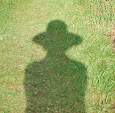The Orkney Isles are full of historical sites to visit: ancient and modern, military and domestic. Normally visiting a military site is not something that quickens my pulse but right next to where we were staying on Hoy was a Martello Tower ... so we decided to pay a visit.
Hackness Battery and Martello Tower were built in 1813–14, at the height of the Napoleonic War. French and American warships were wreaking havoc on British and Scandinavian merchant shipping going north through the Pentland Firth or round the Orkney Isles. Longhope Sound provided a safe anchorage.
Martello Towers take their name from Mortella (Myrtle) Point in Corsica. They are small defensive forts built in various countries of the British Empire during the 19th century from the time of the Napoleonic Wars onwards. There are still quite a few around. (If you read James Joyce"Ulysses" the opening scene takes place on the top of one outside Dublin.)
We decided to take a guided tour of the barracks and the tower. It was absolutely terrific! And this was all because of our outstanding tour guide, Mike Webster. He had a vast knowledge of his subject; we could have stayed all day hearing his stories and learning about for example, ballistics; the difference in hull thicknesses between British and American ships in the time of the Napoleonic Wars, design of the structure, etc.
In the barracks there was one room where the men slept and cooked on a cast iron stove. There were beds all around the perimeter. On each bed was a black wool blanket with the above lettering on one corner. What did the lettering and the arrow symbol mean?
The B and O letters:
This indicates the mark of the Board of Ordnance and the 2 letters plus arrow is a very old mark meaning "Government Property".
[Wikipedia]: "The Office of Ordnance was created by Henry VIII in 1544. It
became the Board of Ordnance in 1597, its principal duties being to
supply guns, ammunition, stores and equipment to the King's Navy."
Mike explained how in the past there were 4
sections to the War Department: Artillary, Infantry, Navy and Ordnance.
The responsibility for surveying was given to the Board of Ordnance rather than the Army or Navy. (Hydrographic surveying stayed with the
Navy.)
The Arrow:
This is called a broad arrow.
[Wikipedia continued]: "The Office and Board used the broad arrow to signify at first objects purchased from the monarch's money and later to indicate government property since at least the 17th century. The introduction of this symbol is attributed to Henry Sydney, 1st Earl of Romney, who served as Master-General of the Ordnance from 1693 to 1702, since the pheon [another word for 'broad arrow'] appears in the arms of the Sidney family.
The broad arrow frequently appeared on military boxes and equipment such as canteens, bayonets and rifles, as well as the British prison uniform from the 1870s, and even earlier, that of transportees in British penal colonies such as Australia."
The broad arrow marks were also used by Commonwealth countries on their ordnance. An example of this is when "the broad arrow was used by the British to mark trees intended for ship building use in North America during colonial times. Three axe strikes, resembling an arrowhead and shaft, were marked on large mast-grade trees." Details of how this practice was used and abused and what it contributed to is
here.
With the demise of the Board in 1855, the War Department and
today's Ministry of Defence continued to use the mark. The arrow also
appears in the Ordnance Survey logo.
And that leads on to the topic of BENCHMARKS (
here). I have seen them around but never knew what they were. Resolution: get some photos and add them here.





















































